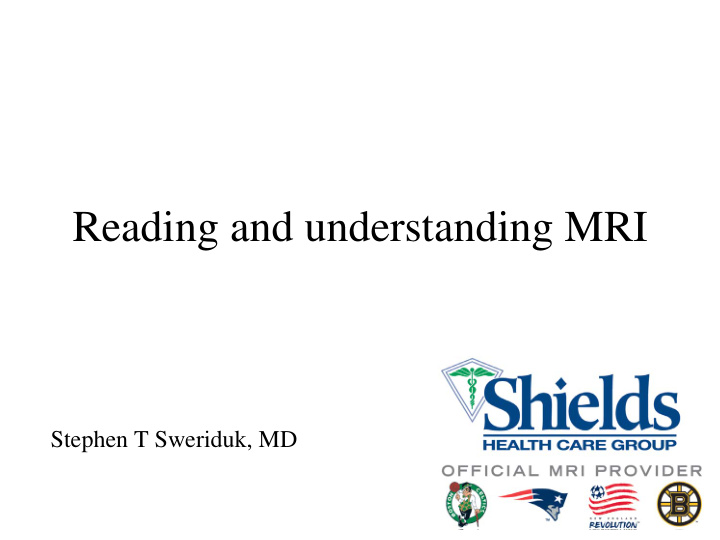



Reading and understanding MRI Stephen T Sweriduk, MD
This workshop will cover basic MRI anatomy of the musculoskeletal system followed by examples of common sports related injuries.
Musculoskeletal MRI
Knee MRI • Knee pain of undetermined etiology • Suspected internal derangement • Meniscal tear, discoid meniscus • Bone contusion, occult fracture • Cruciate and collateral ligament injury • Chondromalacia, patellar tracking disorder • Popliteal cyst, mass • Post-op • bursitis
MENISCAL TEAR
Bone Infarct
Stress fracture
Shoulder MRI • Shoulder pain of undetermined etiology • Rotator cuff tendinosis, tear • Labral tear, instability • Biceps tendon tear, slap lesion • Nerve impingement • Bursitis • Fracture • Impingement syndrome
Rotator Cuff Tear
Hip MRI • AVN • CDH • Transient osteoporosis • Occult fracture • Stress fracture • Transient osteoporosis • Infection • bursitis
April May Regional Migratory Osteoporosis
Avascular Necrosis
Foot and ankle MRI • Ankle and foot pain of undetermined etiology • Tendon and ligament injuries • Sinus tarsi syndrome • Tarsal tunnel syndrome • Plantar fasciitis • Neuroma • Diabetic foot • Infection • Foreign body
Achilles tendon tear
Osteomyelitis
Stress fracture
TMJ MRI • Internal derangement • Closed lock • clicking
Right reduced Left closed lock
ACUTE LOW BACK PAIN
ACUTE LOW BACK PAIN • DURATION LESS THAN 3 MONTHS • MOST COMMON CAUSE OF DISABILITY FOR PERSONS UNDER AGE 45 • UNCOMPLICATED ACUTE LOW BACK PAIN IS A BENIGN, SELF-LIMITED CONDITION WHICH DOES NOT WARRANT ANY IMAGING STUDIES (ACR APPROPRIATENESS CRITERIA 2000)
LOW BACK PAIN CHALLENGE • DISTINGUISH SMALL SEGMENT WITHIN LARGE POPULATION WHICH SHOULD BE EVALUATED FURTHER • Relationship between degenerative disc disease and low back pain not firmly established • Presence of disc abnormalities in asymptomatic population well known
• 1956: McRae performed post mortem studies on entire spine in pts presumed free of symptoms. 40% had HNP at autopsy. • In asymptomatic pts, 24% of myelograms and 36% of CT scans show disc extension beyond interspace • Jensen: 52% asyptomatic pts have disc bulge, 27% have protrusion
LOW BACK PAIN RED FLAGS • RECENT SIGNIFICANT TRAUMA, OR MILDER TRAUMA > AGE 50 • UNEXPLAINED WEIGHT LOSS • UNEXPLAINED FEVER • IMMUNOSUPPRESSION • HISTORY OF CANCER • IV DRUG USE • PROLONGED USE OF STEROIDS, OSTEOPOROSIS • AGE>70
X-RAYS • RECOMMENDED WHEN ANY RED FLAG PRESENT • LS X-RAY MAY BE SUFFICIENT FOR – TRAUMA – PROLONGED STEROID USE – OSTEOPOROSIS – AGE>70 • FURTHER IMAGING NEEDED IF SUSPECT CANCER OR INFECTION
BONE SCAN • LIMITED ROLE IN ACUTE LOW BACK PAIN • YIELD VERY LOW IN PRESENCE OF NORMAL X-RAY • HIGHEST YIELD IN PTS WITH KNOWN MALIGNANCY • CONTRAINDICATED IN PREGNANCY
CT, MRI, MYELOGRAPHY, CT MYELOGRAPHY • NO ROLE FOR ANY OF THESE STUDIES IN UNCOMPLICATED ACUTE LOW BACK PAIN • RESERVE STUDIES FOR RED FLAGS SUCH AS TUMOR, INFECTION • MRI FOR RADICULOPATHY, CAUDA EQUINA SYNDROME (BILATERAL LEG WEAKNESS, URINARY RETENTION, SADDLE ANESTHESIA) – USUALLY DUE TO HERNIATED DISC OR CANAL STENOSIS
L2-L3 Extruded HNP at 0.3T
@ 1:10,000 pts with LBP and radiculopathy will have a conus tumor
Non-discogenic causes of back pain
Metastatic disease
Infection
Diskitis and Osteomyelitis • Pyogenic disc space infection usually result of blood borne agent, lung or urinary tract • begins in end plate • organisms: staph>>strep, Ecoli, • MRI; T1 dark, T2 bright (involved disk brightest), disc space, disc, and paravertebral tissues if involved will enhance
CONGENITAL
tethered cord Lipoma and
Chronic neck pain: imaging recommendations • AP, LATERAL OPEN MOUTH X-RAY • IF NORMAL AND NO NEURO SIGNS OR SXS, NO FURTHER IMAGING • IF NORMAL AND HAVE NEURO SIGNS OR SXS, PERFORM MR • IF X-RAY POSITIVE FOR SPONDYLOSIS, NO NEURO SIGNS OR SXS, NO FURTHER IMAGING • IF X-RAY POSITIVE FOR SPONDYLOSIS, POSITIVE NEURO SIGNS AND SXS, PERFORM MR • IF X-RAY SHOWS BONE OR DISC MARGIN DESTRUCTION, PERFORM MR
Cervical: Herniation, Syrinx C6-7 Courtesy Longmont United Hopsital TR 4500, TE 138, 4mm, 256 2 TR 6850, TE 134, 4mm, 256 7 ½ min 7 min.
Compressive myelomalacia Pre-op 1.5T
Metastatic breast carcinoma
Questions?
Recommend
More recommend